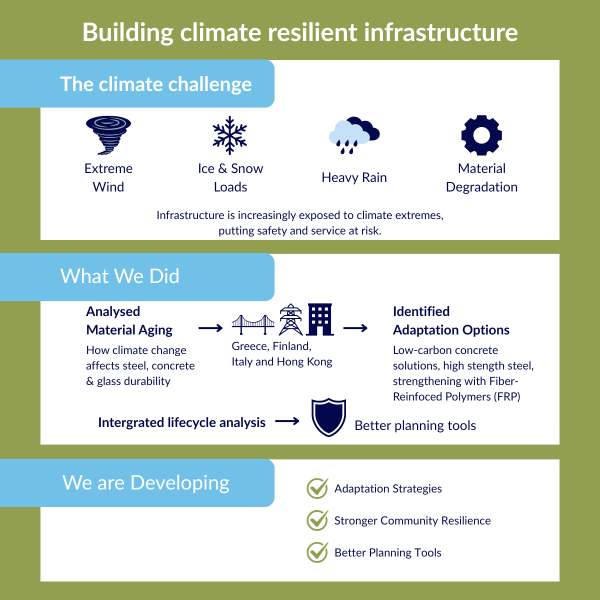Work Package 4
Work Package Name: Multi-Hazard Vulnerability and Adaptation, Structural Resistance Integration in Lifecycle Analyses
Lead Beneficiary: USTUTT

Work Package 4 focuses on assessing how critical infrastructure responds to multiple climate-related hazards—such as extreme wind, ice, and heavy rain and identifying structural adaptation strategies to reduce long-term risk. The work addresses both current vulnerabilities and future challenges by evaluating how structural materials, such as steel and concrete, degrade over time under changing climate conditions.
Through detailed analyses across four pilot sites, including a bridge in Greece, a power transmission line in Finland, a concrete hospital building in Italy and three high-rise building with glass facades in Hong Kong, WP4 examines the structural performance of assets under climate-related loads and explores targeted adaptation options, such as low-carbon materials and innovative retrofitting techniques. It also integrates lifecycle and cost assessments to ensure that proposed solutions are both technically robust and economically viable. The insights gained feed directly into the RISKADAPT platform, supporting evidence-based decision-making for resilient, climate-adapted infrastructure systems.
Deliverables
The current deliverable presents a methodological approach to assess the present and future structural vulnerability, of selected infrastructures (pilots), in connection to the mechanical properties of the materials and their degradation evolution under adverse weather conditions such as among others, extreme winds, heavy rains, and ice, taking also into account the effects of Climate Change (CC). First, an approach for the estimation of the time-dependent corrosion degradation of structural steel and reinforcing steel bars either in normal or prestressed concrete is presented. Then, the results of the above process are elaborated in the estimation of structural vulnerability to Pilots 1-3 of the project both at present and future times. More specifically, Pilot 1 refers to “the Polyfytos bridge” constructed over the lake Polyfytos near the town of Kozani in Greece, operating in less than full capacity for some period due to important structural problems because of the partial loss of the required prestressed tendons capacity induced by severe corrosion. Pilot 2 considers power transmission towers in Finland. For those towers, the effect of CC on atmospheric icing conditions and high winds to power transmission towers (ice load combined with winds) was evaluated. Pilot 3 refers to Cattinara Hospital which is a major high rise public hospital building in Trieste, Italy, exposed to high winds, suffered in the past, such as in February 2012, where nonstructural damages in fittings and plasters were produced. Pilot 4 of RISKADAPT project is related to the assessment of glass window damage in high rise buildings in Hong Kong due to high wind flows and wind-driven rain. The approach followed for Pilot 4 differs from that in Pilots 1-3. In specific, glass windows are non-structural elements, and they do not affect the structural capacity of the building, but they only contribute to serviceability. Thus, for Pilot 4, to point out the effect of extreme weather on high rise buildings, a description of Hong Kong regulations on glass windows was made followed by a history of failure events attributed to high winds. Moreover, for that pilot, algorithms for the glass window damage were developed and presented in RISKDAPT D3.6. The deliverable ends providing information on possible adaptation options that are applicable to the assets of Pilots 1-3. First, techniques with low carbon precast concrete and their properties are presented. These materials, apart from any novel technical solutions may offer, also aim at shaping policies (decarbonization, circular economy) and standards (precast concrete and sustainability). Besides precast concrete, additional rehabilitation techniques such as the restoration of the structural steel (which could be applicable to Pilot 2) or other refurbishment techniques relevant to the reinforcing steel in concrete structural components (which could be applicable to Pilots 1 and 3) through fiber glass/carbon polymers or steel jacketing are presented.
In general, under operating loads, the structural elements of a structure are normally under compressive forces and relatively small values of biaxial bending moments whereas under extreme transversal/horizontal loadings, such as an unexpected high value of wind pressure or flood conditions a threshold approach of limit states, can be followed to categorize system components into safe and unsafe conditions. This uncertainty in structural behavior is considered by modelling the load effects on the structure, the geometrical data, the strength, the toughness and the mechanical characteristics which can change due to the material degradation, as random variables. An appropriate methodological framework is applied in RISKADAPT project for assessing the structural vulnerability of the structures considered in the Pilots 1-3. More specifically, first the methodology follows appropriate standards and models for estimating the material degradation of structural materials (concrete and steel) based on climate and environmental parameters. For the climate parameters such as temperature and relative humidity, data based on the Shared Socioeconomic Pathways (SSPs) were provided by FMI. Then, the aforementioned methodology is applied on Pilots 1-3 to evaluate the expected material degradation issues and any possible effects on structure’s condition and vulnerability. The vulnerability of the structures of Pilots 1-3 is assessed by performing appropriate structural analyses and estimating the structural risk under various scenarios of the climatic hazards considered in each case (i.e., extreme wind, ice loads) both in present and future times. Results obtained show that the impact of CC on structural performance cannot be generalised. Rather, structural performance should be assessed individually for each structure, considering differences of the above impact in different European regions and the peculiarities of each structure. For instance, in the case of energy transmission towers in Finland (pilot 2), the impact of CC is positive for structural safety as it lowers the weight of the ice on the lines. On the other hand, CC promoting heavy rains can be detrimental for old bridges subjected to scouring. This is even more so in the case of highway bridges subjected to de-icing salts in the winter (pilot 1). In the case of the Italian hospital (pilot 3), even though CC will increase the temperature and, thus, the rate of corrosion, the high safety factors provided by the codes keep adequate structural safety. Finally, regarding glass window damage the past experience of recorded events show that high-rise buildings especially in areas prone to cyclones such as Hong Kong (Pilot 4) may lead to extensive damages affecting the serviceability of the building and sometimes having significant societal impact such as injuries or deaths.
Included in the last part of the document are potential adaptation options that are applicable for rehabilitation or strengthening of the structures considered herein. The evaluation of each adaptation option will be performed in a following stage of the project. The results presented in the deliverable constitute the output of the structural analysis tasks and provide input for the LCA/LCC analyses (under T4.5) and will also be fed in the RISKADAPT platform (under WP5). Moreover, external stakeholders including local and regional authorities that own constructed facilities, business or private owners of facilities, developers, investors, financiers, insurers, as well as the supply side of structural adaptation communities (civil engineers, contractors, material and product suppliers) and civil protection authorities may benefit from the work presented in the current deliverable.
Read the full deliverable here.
This deliverable, as part of the EU-funded project RISKADAPT (Grant Agreement No. 101093939), addresses the objectives of Task 4.5: Probabilistic LCA/LCC Model Development. It introduces an innovative probabilistic framework for Life Cycle Assessment (LCA) and Life Cycle Costing (LCC), with a focus on structural resistance integration for infrastructures impacted by climate change-induced extreme weather events. The primary purpose is to assess environmental and economic impacts of restoration measures and propose sustainable adaptation strategies by enhancing conventional LCA/LCC methodologies with uncertainties and variabilities arising from extreme weather events. It seeks to enable practitioners and decision-makers to evaluate structural adaptation options, balancing environmental sustainability and economic efficiency.
This deliverable describes and demonstrates a novel probabilistic LCA/LCC framework called the Predictive Risk-Integrated Dynamic Environmental Life Cycle Analyses approach (PRINTED). This methodology integrates uncertainty analysis through probabilistic risk assessment, evaluates potential adaptation options for infrastructure considering both environmental and economic impacts, and uses a Monte Carlo simulation to analyse variability in results and assess decision-making robustness under different climate scenarios. The methodology is illustrated through a case study of a power transmission tower in Finland, which constitutes Pilot 2 of RISKADAPT project. Various structural adaptation options, such as high-strength steel (HSS) and fiber-reinforced polymer (FRP) strengthening, were analysed for their performance under extreme climate conditions.
This deliverable contributes to RISKADAPT by offering a scalable framework to incorporate probabilistic assessments in infrastructure lifecycle analyses, enabling informed decision-making for infrastructure resilience against climate risks, and promoting sustainable construction practices by identifying eco-friendly and cost-effective adaptation solutions.
The primary beneficiaries of this work include LCA practitioners and experts interested in applying probabilistic approaches to lifecycle assessments, decision-makers and market players in green construction seeking sustainable and resilient solutions for infrastructure adaptation, and environmental NGOs and policymakers focused on mitigating climate change impacts through evidence-based strategies.
The probabilistic LCA/LCC framework addresses the gap in current methodologies by accounting for uncertainties in climate scenarios and adaptation impacts. HSS adaptation scenarios demonstrated lower environmental impacts due to material optimisation, while FRP strengthening provided a feasible option for corroded structures. Climate scenarios significantly influenced failure probabilities, with results highlighting the importance of region-specific assessments. The methodology, demonstrated with publicly available datasets, ensures broader applicability and cost-effectiveness for stakeholders.
This deliverable advances the understanding of sustainable infrastructure adaptation, providing a robust, probabilistic approach that aligns with the overarching goals of the RISKADAPT project to mitigate climate risks effectively.
